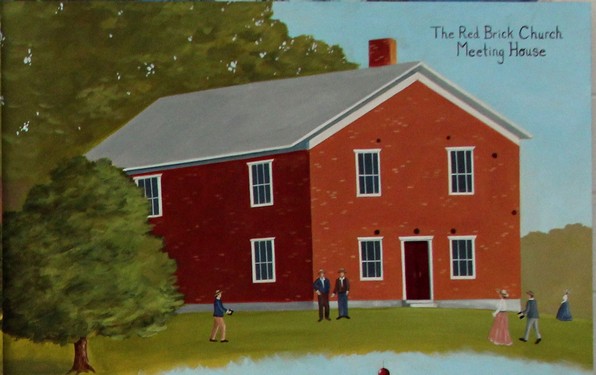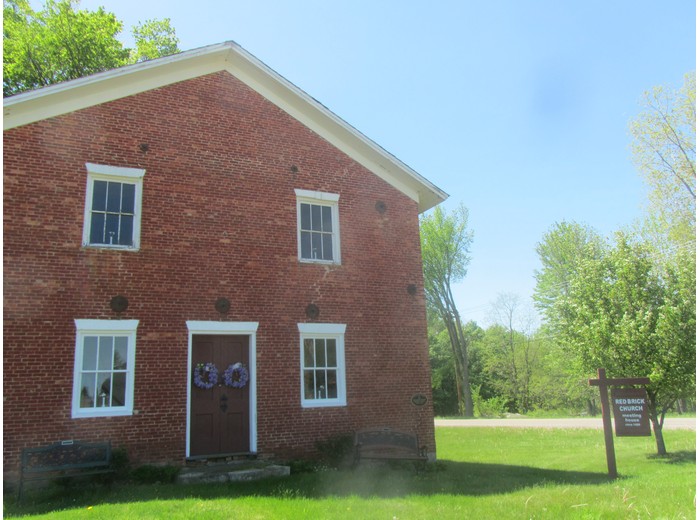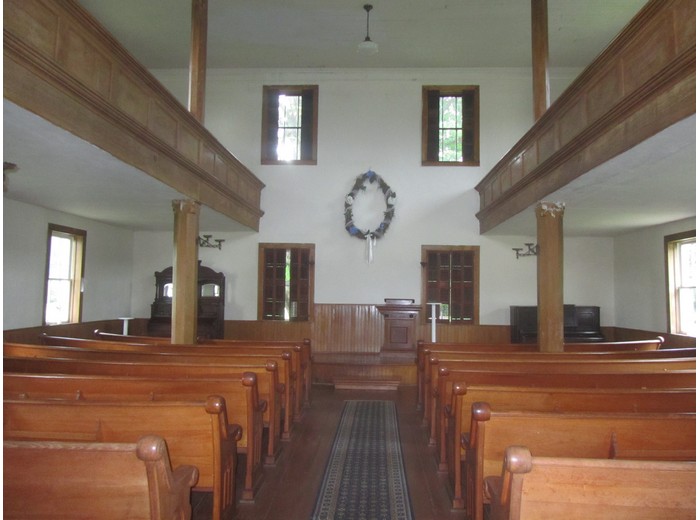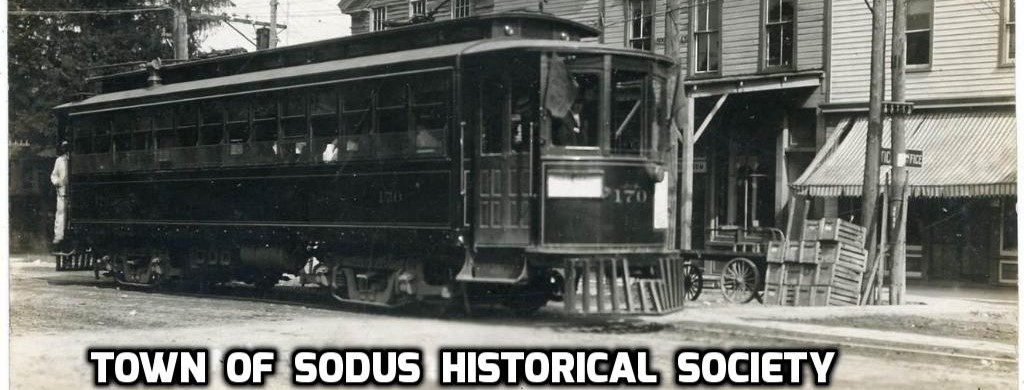


Photos courtesy of Edith Farrington. This church is the oldest Baptist Church in Wayne County.
The Red Brick Meeting House (Church) of Sodus Center
The following information is an excerpt from a composition written by D. Aaron Wunder (1996)
The land was deeded to trustees of the “First Baptist Society of Sodus” by Lord Alloway and Masteron Ure for a chapel and burying ground. Work was started in 1824 and the opening ceremony was in July of 1826. The brick used in the building was fired from the red clay deposits found a mile north of the church on Geneva Rd.
Without a police force the church had the duty and responsibility to act as judge and jury until legal authorities assumed this role. Some members of the church were “excluded” for working on the Sabbath, gossiping and the recorded adultery case banished both the woman and the man from the congregation.
In 1834 fifty members were allowed to leave and form a new church in the west part of the Town of Sodus, and the first clerk was named James Hopkins. This was the same year that William Walling open his tavern in present day Wallington and it is felt that the “saloon” may have triggered the split but can’t be proven. William Walling was the largest mortgage holder for the church and in 1843 the Church decided to tax its members and pay him off. William Walling and the Red Brick Church were forever separated when the church property was incorporated in the hamlet of Sodus Center, not Wallington.
The single American fatality of the Battle of Sodus Point in 1813, Asher Warner, is laid to rest in this cemetery along with over 20 soldiers of the Revolutionary War and the war of 1812. And there are over 140 honored veterans of domestic and foreign conflicts also laid to rest here. But even earlier than this, Native Americans had used this place even prior to the earliest dated tombstone of 1809.
After years of declining members, the church was disbanded in 1926, 100 years after its start. Fearing that the property might be sold to “unsympathic parties or fall prey to arrogant agents of progress”, local history enthusiast Edward C. Delano bought the property. The Church and surrounding grounds became the ward of the Sodus Center Baptist Rural Cemetery Association on July 25, 1927
The structure is in exceptional preservation and continues to hold services and ceremonies for weddings and other events. With no electric, the simple and sincere atmosphere is preserved. On August 8, 1996 it was placed on the New York State and National Register of Historic Places.
Another person who was very influential in the establishment of the meeting house was Elder Norton. Elder Norton was a former Revolutionary War soldier who initially was in charge of the volunteers who showed up to defend Sodus Point during the British attack during the War of 1812. Here is an account of his involvement in the early days of the meeting house as written in “History of the Churches of Sodus” by Lewis H. Clarke page V (appendix):
The church which afterward occupied the Brick Meeting house, met for several years at the Merchant School house at the junction of what used to be called the Old and New roads (to Lyons.) Elder Norton quarried the stone for the foundation of the brick house and obtained a grant of three acres from the land office, for house, parsonage and burial ground. He afterwards took up the whole lot, that they might have a right to what timber they wanted for building, and when they had done, sold it to Mr. Butler. In building they fell short and he donated a large amount of seasoned lumber which he had laid up to finish his own house. James Walling was deacon at an early day. At my first knowledge of Sodus Milton Granger and Lawrence Vosburgh were deacons. David Paul was next chosen, and afterwards Thomas Hopkins and Michael Hollenbeck. Sometime before I knew anything of Sodus, Elder Norton retired from active service and Elder Martin Miner became the pastor. Elder Norton was again pastor a year or more, when the church, as his request in 1834 called me (a Licentiate,) to preach with Elder Norton to administer the ordinances. I continued with them statedly two years; afterwards occasionally with C. C. Rogers, (a licentiate,) till they called Elder Joseph Gould as pastor.
